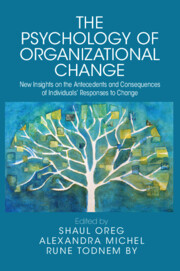 The Psychology of Organizational Change
The Psychology of Organizational Change Book contents
- The Psychology of Organizational Change
- The Psychology of Organizational Change
- Copyright page
- Contents
- Contributors
- Part I Introduction
- Part II The Evolution of Change and Its Responses
- Part III Change in Context
- Part IV The Development of Change Leadership
- Part V The Process of Change Leadership
- Chapter 11 Building Commitment to Organizational Change
- Chapter 12 Change Leadership
- Part VI Conclusions and Commentary
- Index
- References
Chapter 11 - Building Commitment to Organizational Change
The Important Role of Leadership
from Part V - The Process of Change Leadership
Published online by Cambridge University Press: 28 September 2023
- The Psychology of Organizational Change
- The Psychology of Organizational Change
- Copyright page
- Contents
- Contributors
- Part I Introduction
- Part II The Evolution of Change and Its Responses
- Part III Change in Context
- Part IV The Development of Change Leadership
- Part V The Process of Change Leadership
- Chapter 11 Building Commitment to Organizational Change
- Chapter 12 Change Leadership
- Part VI Conclusions and Commentary
- Index
- References
Summary
Successful organizational change requires the commitment of those charged with its implementation. We focus on the role that organizational leaders play in the development and maintenance of employees’ commitment to organizational change. We review a recent but growing body of research linking leadership to change commitment, beginning with transformational leadership, new genre leadership, change leadership, and change-specific leader behavior. In each case, we examine the link between leadership style/behavior and followers’ commitment to change, the mediating mechanisms (e.g., climate of trust, change self-efficacy) that help to explain the link, and the moderating conditions (magnitude of the change, impact on employees) that influence the strength or direction of the relationship. Evidence suggests that, although leadership at all levels can have an impact, direct managers play a particularly important role in fostering commitment and behavioral support for the change within their units. Organizations are advised to attend to this role in the planning and implementation of change, particularly when the change is likely to have a wide-ranging impact and require commitment at all levels.
Keywords
- Type
- Chapter
- Information
- The Psychology of Organizational ChangeNew Insights on the Antecedents and Consequences of Individuals' Responses to Change, pp. 237 - 262Publisher: Cambridge University PressPrint publication year: 2023


